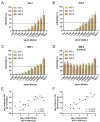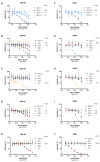High-Throughput Platform for Detection of Neutralizing Antibodies Using Flavivirus Reporter Replicon Particles
- PMID: 35215941
- PMCID: PMC8880525
- DOI: 10.3390/v14020346
High-Throughput Platform for Detection of Neutralizing Antibodies Using Flavivirus Reporter Replicon Particles
Abstract
Flavivirus outbreaks require fast and reliable diagnostics that can be easily adapted to newly emerging and re-emerging flaviviruses. Due to the serological cross-reactivity among flavivirus antibodies, neutralization tests (NT) are considered the gold standard for sero-diagnostics. Here, we first established wild-type single-round infectious virus replicon particles (VRPs) by packaging a yellow fever virus (YFV) replicon expressing Gaussia luciferase (Gluc) with YFV structural proteins in trans using a double subgenomic Sindbis virus (SINV) replicon. The latter expressed the YFV envelope proteins prME via the first SINV subgenomic promoter and the capsid protein via a second subgenomic SINV promoter. VRPs were produced upon co-electroporation of replicon and packaging RNA. Introduction of single restriction enzyme sites in the packaging construct flanking the prME sequence easily allowed to exchange the prME moiety resulting in chimeric VRPs that have the surface proteins of other flaviviruses including dengue virus 1--4, Zika virus, West Nile virus, and tick-borne encephalitis virus. Besides comparing the YF-VRP based NT assay to a YF reporter virus NT assay, we analyzed the neutralization efficiencies of different human anti-flavivirus sera or a monoclonal antibody against all established VRPs. The assays were performed in a 96-well high-throughput format setting with Gluc as readout in comparison to classical plaque reduction NTs indicating that the VRP-based NT assays are suitable for high-throughput analyses of neutralizing flavivirus antibodies.
Keywords: diagnostics; flavivirus; high-throughput; neutralization assay; virus replicon particles.
Conflict of interest statement
The authors declare no conflict of interest.
Figures





Similar articles
-
High-throughput neutralization assay for multiple flaviviruses based on single-round infectious particles using dengue virus type 1 reporter replicon.Sci Rep. 2018 Nov 9;8(1):16624. doi: 10.1038/s41598-018-34865-y. Sci Rep. 2018. PMID: 30413742 Free PMC article.
-
Virus replicon particle based Chikungunya virus neutralization assay using Gaussia luciferase as readout.Virol J. 2013 Jul 15;10:235. doi: 10.1186/1743-422X-10-235. Virol J. 2013. PMID: 23855906 Free PMC article.
-
Seroprevalence of Flavivirus Neutralizing Antibodies in Thailand by High-Throughput Neutralization Assay: Endemic Circulation of Zika Virus before 2012.mSphere. 2021 Aug 25;6(4):e0033921. doi: 10.1128/mSphere.00339-21. Epub 2021 Jul 14. mSphere. 2021. PMID: 34259560 Free PMC article.
-
Mapping the diverse structural landscape of the flavivirus antibody repertoire.Curr Opin Virol. 2020 Dec;45:51-64. doi: 10.1016/j.coviro.2020.07.006. Epub 2020 Aug 13. Curr Opin Virol. 2020. PMID: 32801077 Free PMC article. Review.
-
Establishment and Application of Flavivirus Replicons.Adv Exp Med Biol. 2018;1062:165-173. doi: 10.1007/978-981-10-8727-1_12. Adv Exp Med Biol. 2018. PMID: 29845532 Review.
Cited by
-
Prior flavivirus immunity skews the yellow fever vaccine response to cross-reactive antibodies with potential to enhance dengue virus infection.Nat Commun. 2024 Feb 24;15(1):1696. doi: 10.1038/s41467-024-45806-x. Nat Commun. 2024. PMID: 38402207 Free PMC article.
-
A Recombinant Porcine Reproductive and Respiratory Syndrome Virus Stably Expressing a Gaussia Luciferase for Antiviral Drug Screening Assay and Luciferase-Based Neutralization Assay.Front Microbiol. 2022 May 13;13:907281. doi: 10.3389/fmicb.2022.907281. eCollection 2022. Front Microbiol. 2022. PMID: 35633700 Free PMC article.
-
Mutations in the non-structural protein coding region regulate gene expression from replicon RNAs derived from Venezuelan equine encephalitis virus.Biotechnol Lett. 2023 Aug;45(8):1029-1038. doi: 10.1007/s10529-023-03379-7. Epub 2023 Jun 2. Biotechnol Lett. 2023. PMID: 37266878
-
Single-dose mucosal replicon-particle vaccine protects against lethal Nipah virus infection up to 3 days after vaccination.Sci Adv. 2023 Aug 4;9(31):eadh4057. doi: 10.1126/sciadv.adh4057. Epub 2023 Aug 4. Sci Adv. 2023. PMID: 37540755 Free PMC article.
-
Nanoluciferase Reporter Zika Viruses as Tools for Assessing Infection Kinetics and Antibody Potency.Viruses. 2023 Oct 31;15(11):2190. doi: 10.3390/v15112190. Viruses. 2023. PMID: 38005868 Free PMC article.
References
-
- de Oliveira Figueiredo P., Stoffella-Dutra A.G., Barbosa Costa G., Silva de Oliveira J., Dourado Amaral C., Duarte Santos J., Soares Rocha K.L., Araújo Júnior J.P., Lacerda Nogueira M., Zazá Borges M.A., et al. Re-Emergence of Yellow Fever in Brazil during 2016–2019: Challenges, Lessons Learned, and Perspectives. Viruses. 2020;12:1233. doi: 10.3390/v12111233. - DOI - PMC - PubMed
-
- WHO Yellow Fever—Brazil. [(accessed on 22 December 2021)]. Available online: https://www.who.int/emergencies/disease-outbreak-news/item/11-february-2....
Publication types
MeSH terms
Substances
LinkOut - more resources
Full Text Sources
Research Materials

